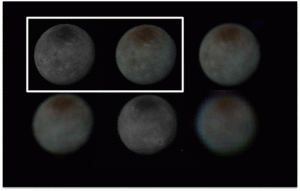Reposted from https://blogs.nasa.gov/pluto/2016/02/12/the-many-faces-of-pluto-and-charon/.
Today’s blog post is from Kimberly Ennico, a member of the New Horizons’ Composition Theme Team and one of the deputy project scientists. She works at NASA’s Ames Research Center in Moffett Field, California, and has been on detail to the Southwest Research Institute in Boulder, Colorado.
No one can doubt the beauty of Pluto and Charon—amazing worlds revealed by the images from NASA’s New Horizons mission. From Pluto’s mountains, glaciers, ice-volcanoes, blue skies, and layered colorings to Charon’s vast tectonic structures and enigmatic red-colored pole, these pictures and associated spectra are rich puzzles waiting to be solved.
The July 14, 2015 Pluto flyby gave us an initial look at one side of Pluto, with its iconic heart-shaped feature. But I’m interested in the full planetary perspective, finding the “other sides” of Pluto to be every bit as fascinating as the encounter hemisphere. We must remember that a flyby is a moment in time lasting a few hours. In contrast, Pluto and Charon each rotate about its axis every 6.4 Earth days. This means that when New Horizons flew through the Pluto system it captured one hemisphere of each body in incredible detail.
What do we know about the “other sides” of Pluto and its largest moon? In the three weeks before the flyby, the Long Range Reconnaissance Imager (LORRI) and Multispectral Visible Imaging Camera (MVIC) imaged Pluto and Charon every day, sometimes two or three times a day to gather as much coverage across the bodies as New Horizons closed in. LORRI is New Horizons’ primary camera, an 8-inch telescope outfitted with an unfiltered charge-coupled device (CCD) – like you’d find in your own digital camera – sensitive to visible light. MVIC is a separate instrument with multiple CCDs, for which several are outfitted with color filters. The highest resolution images of the “other sides” of Pluto and Charon were observed 3.2 Earth days earlier, around July 10-11.
Working with a subset of the data (as not all these images have been sent to Earth from New Horizons yet), we’ve received our first glimpse of these “non-encounter” hemispheres below.
Four faces of Pluto in black-and-white and color. From left to right, the central sub-observer longitudes are ~180, 240, 360 and 60 degrees East Longitude. The Pluto “Encounter Hemisphere” (indicated by the white box) is most recognizable by the “heart” feature of the informally-named Tombaugh Regio. This is also the hemisphere that today never faces Charon, as Charon is “tidally locked” to Pluto, similarly to how the Earth only sees one face of our moon. Pluto’s “Charon-facing” side is the second column from the right. Pluto’s north pole is up in all these images. The top row contains LORRI grey-scale images taken on July 13, July 12, June 27 and July 3rd, when Pluto was 620, 189, 24 and 36 LORRI pixels across, respectively. The bottom row shows MVIC “enhanced-color” images made by combining the near infrared, red and blue filters. They were taken on July 13, July 12, July 10 and July 9, when Pluto was 163, 56, 26 and 21 MVIC color pixels across, respectively. All these images surpass what we had previously seen from Hubble Space Telescope imagery where Pluto’s disk was only about 12 pixels across. Of course, New Horizons was only millions of miles from Pluto—Hubble is over 3 billion miles away! Credits: NASA/JHUAPL/SwRI
Six faces of Charon. Central sub-observer longitudes: top, from left to right, 350 (B&W), 2 (color), 32 (color); Bottom, from left to right, 67 (color), 86 (B&W), and 180 (color) degrees East Longitude. The side that faces Pluto is highlighted by the inset box. From left to right, the top row images were taken July 14, 14 and 13, 2015, with Charon spanning 523 (LORRI), 81 (MVIC), and 43 (MVIC) pixels. The bottom row images were captured from July 12, 12 and 10, 2015, with Charon spanning 28 (MVIC), 96 (LORRI), and 13 (MVIC) pixels. Charon remains a mainly neutral greyish color all around, with a distinct red northern polar cap appearing from all sides. Credits: NASA/JHUAPL/SwRI
What strikes me most about the new Pluto color images is that the latitudinal (horizontal) banding identified on the encounter hemisphere is evident all around Pluto. Specifically, the northern polar region has a distinctive color from adjacent latitudes. The darkest region, which spans the equator, also appears to continue around Pluto, showing distinct variations on the side facing Charon, which have yet to be understood.
Why is this interesting? Coloring on Pluto is thought to have been the result of hydrocarbons called tholins that have formed in the atmosphere and have been “raining” down on Pluto’s surface over the millennia. We’re investigating whether Pluto’s colored terrains are primarily due to changes in or movements of its surface ices, specifically whether they have been undergoing seasonal effects –changing in temperature over time from the amount of cumulative sunlight – which could display itself as horizontal banding. The presence of that vast reservoir of methane, nitrogen and carbon monoxide ices in Pluto’s “heart” complicates the picture and could serve as a visible marker to trace changes.
Over the next few months, as more of this late-approach imagery gets downlinked from the spacecraft’s recorders, we will continue to piece together this colorful story of Pluto and Charon – from all sides.


